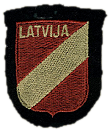9
Shabtai Dolgizer was brought to the Prefecture in mid-July. His description of the treatment he received there (tr. 486-5001) comports with that of Mendelkorn and Wulfowitz.
The Jews were pushed and shoved, forced to run up and down stairs, do exercises, and clean the courtyard with toothbrushes. The shoving was done with rifle butts; some of those who were pushed never got up again.
C. THE GOGOL STREET SYNAGOGUE
In July, 1941, the largest synagogue in Riga was located on Gogol street, a few blocks from the Prefecture. The witness 1Ber Mendelkorn testified that he found refuge in his aunt's house on Gogol street after escaping from a work detail, (tr. 472) From a window on the second floor of that house, he 2saw the synagogue set on fire. He states that the respondent pushed Jews into the Synagogue before it was set on fire. (tr. 613, 55-564)
The 3destruction of synagogues in Riga was confirmed in Operational Situation Report No. 15, of July 7, 1941, and in document L-180.
D. ESTABLISHMENT OF GERMAN CONTROL: THE GHETTO
4In the first days of the German occupation of Riga, the Latvian Self-Government was allowed to exercise the authority of the displaced Soviet administration. This was permitted for two reasons: first, the occupation government was not in a position to exert
Examination
1“Ber Mendelkorn” . . . 2“saw the synagogue set on fire. He states that the respondent pushed Jews into the Synagogue before it was set on fire.”
Hāzners was proven to not be in Rīga when Mendelkorn testified he saw him. Mendelkorn's testimony proved problematic: from seeing Hāzners where he could not have been or had no reason to be present to emphatically testifying as to the officer's rank Hāzners wore, indicating his rank at the end of the war and not at the time Mendelkorn alleges to have seen him.
If anything, that the Gogol street synagogue was burned down no later than the 7th of July serves to exonerate, not convict, Hāzners, who was not in Rīga at the time.5
When the Soviets' propagandist synagogue-burning accusation against Hāzners failed, Soviet diplomats subsequently lodged the very same accusation against "Khazners"6 at the United Nations in February, 1983, twenty years after publishing Daugavas Vanagi, Who are They?, only moving the scene from Rīga to Byelorussia (Belarus)—proof that Hāzners never left the top of the KGB "hit list," that the charges were fabrications all along, and that Mendelkorn was at best mistaken regarding Hāzners's identity, at worst spinning tales based on his collection of anti-Hāzners Soviet propaganda which was placed into evidence.
Here (and continuing on the following page) we have the final stake in the heart of the INS's false "historical facts", the contention that a central Latvian authority (i.e., the afore-mentioned Dankers Self-Government) existed and exercised authority in the place of the departed Soviets. This is propaganda, plain and simple, for which the INS provides no substantiation.
| 1 | Testimony of Shabtai Dolgizer, 31-October-1977, direct, transcript pp. 475–517A. |
| 2 | Testimony of Ber Mendelkorn, 25-October-1977, direct, transcript pp. 15–93. |
| 3 | Testimony of Ber Mendelkorn, 25-October-1977, direct, transcript pp. 15–93. |
| 4 | Testimony of Ber Mendelkorn, 25-October-1977, direct, transcript pp. 15–93. |
| 5 | The synagogue was burned on the 4th of July. |
| 6 | An error in double-transliteration from Latvian to Russian to English. |
